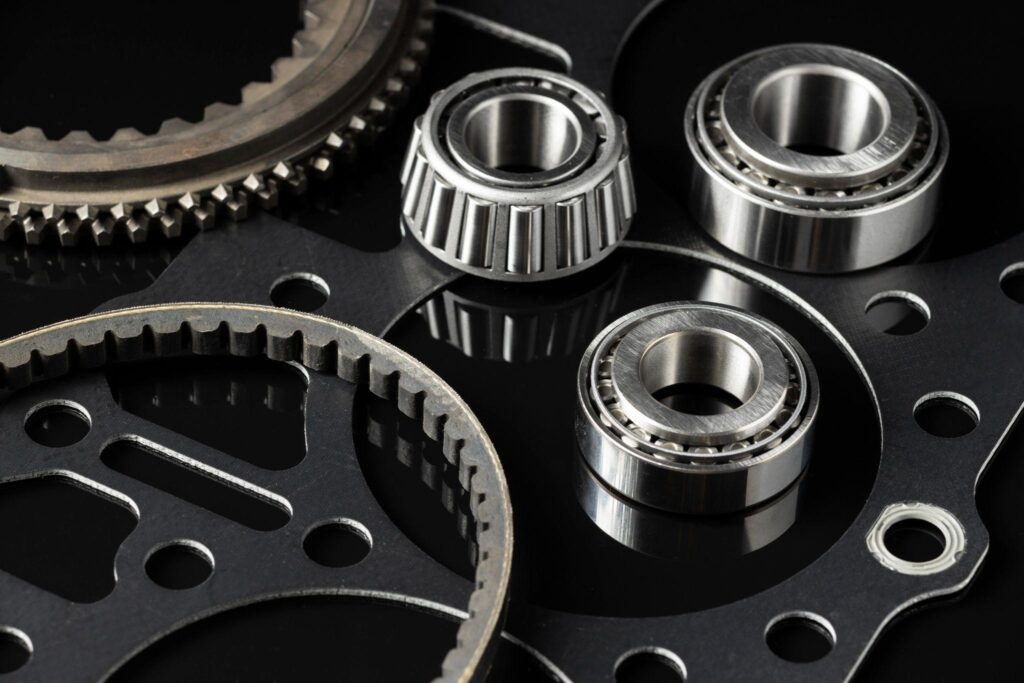In many mechanical systems, ball bearings are essential for enhancing linear motion. By lowering friction between moving parts, these precision parts guarantee efficient and smooth motion along a straight route. Their significance is especially noticeable in sectors like manufacturing, automotive, and aerospace. We can appreciate industrial ball bearings‘ crucial role in improving operational efficiency by having a basic understanding of them and their uses in linear motion systems.
Definition of Ball Bearings:
Ball bearings are precision-engineered devices consisting of an outer ring, an inner ring, balls, and a cage or separator. They are specifically designed to facilitate rotational or linear motion by minimizing friction between moving parts. The balls’ rolling contact with the rings’ raceways forms the core of the ball bearings’ mechanism, allowing smooth and low-resistance motion. These components are commonly used in applications where high precision and efficiency are paramount, such as in super precision ball bearings, which offer exceptionally low friction and high accuracy.
Types of Ball Bearings:
Deep Groove Ball Bearings: Among the most commonly used industrial ball bearings, deep groove ball bearings are versatile and suitable for various applications. With a deep, continuous raceway on both the inner and outer rings, they can handle radial and moderate axial loads in both directions. Known for their low friction and quiet operation, these bearings can operate at high speeds. They are typically used in electric motors, household appliances, pumps, and automotive components.
Angular Contact Ball Bearings: Designed to manage both radial and axial loads, these bearings have raceways on both rings, with one raceway inclined at an angle to the bearing’s axis. The angular contact design allows these bearings to handle higher axial loads in one direction. Frequently used in pairs or sets to increase load capacity, they are ideal for applications such as machine tools, automotive wheels, and gearboxes.
Thin-Section Bearings: Thin-section bearings have very small cross-sections relative to their diameters, enabling compact, lightweight designs while maintaining high rigidity and running accuracy. Unlike standard rolling bearings, which have a larger cross-section as the bearing diameter increases, thin-section bearings in a given series maintain the same cross-section across sizes. This allows for the selection of a high load-carrying capacity without modifying the shaft diameter. Thin-section bearings are available in deep groove, four-point contact, and angular contact configurations. They are commonly used in handling devices, industrial robots, textile and printing machinery, medical and optical equipment, and aerospace engineering.
Each type of ball bearing has unique characteristics, making it suitable for different load conditions and applications. Choosing the right bearing depends on factors such as load capacity, speed, and space constraints. For highly precise applications, super precision ball bearings are the preferred choice, offering superior performance in demanding environments.
Working Principle of Ball Bearings:
Friction Reduction: One of the primary functions of ball bearings is to reduce friction between moving parts. By replacing sliding friction with rolling friction, ball bearings significantly lower energy loss and wear. The spherical shape of the balls allows them to move smoothly between the raceways, ensuring efficient and energy-saving operation in linear motion systems.
Load Distribution: In linear motion systems, varying loads and forces are common. Ball bearings help evenly distribute these loads across their contact surfaces, reducing the likelihood of premature wear or failure. By distributing radial and axial loads, industrial ball bearings improve the overall stability, longevity, and reliability of mechanical systems.
Effortless Linear Motion: Ball bearings are designed to enable smooth linear motion. Their low-friction properties, combined with rolling contact, allow precise and stable movement in a straight line. This is especially critical in applications that require accurate positioning and minimal deviation from the intended direction. Super precision ball bearings excel in such applications, providing high levels of accuracy and repeatability.
Applications of Ball Bearings in Linear Motion Systems:
Industrial Machinery-
Conveyor Systems: Ball bearings play a key role in ensuring the smooth operation of conveyor systems. They are typically used in rollers and pulleys to reduce friction and allow the conveyor belt to move efficiently, improving the productivity of industrial machinery.
Linear Actuators: Common in industries like robotics and packaging, ball bearings are integral to linear actuators, enabling precise and consistent linear movement. By reducing friction, these bearings ensure accurate positioning and repeatability in systems requiring precise displacement.
Robotics: In robotics, ball bearings are crucial for achieving smooth articulation in robotic arms and joints. Their ability to reduce friction while maintaining precision enhances the performance and flexibility of robots, particularly in industrial ball bearings applications where agility and power efficiency are key.
Automotive Sector-
Suspension Systems: Ball bearings are critical in automotive suspension systems, ensuring smooth operation and stability. They are used in shock absorbers and struts to absorb vibrations and shocks, providing a comfortable and controlled ride.
Steering Systems: Steering systems rely on ball bearings to allow smooth and precise movement, enhancing vehicle handling and control.
Transmission Systems: In both manual and automatic transmissions, ball bearings support rotating shafts and gears, enabling smooth power transfer. Their ability to reduce friction improves the efficiency of the gearbox and contributes to quieter, more reliable operation.
Aerospace Industry-
Flight Control Systems: Super precision ball bearings are vital in aerospace applications, particularly in flight control systems that require highly accurate and responsive motion control. These bearings ensure smooth movement of control surfaces, contributing to the aircraft’s maneuverability and safety.
Landing Gear Mechanism: In landing gear, ball bearings provide support for wheels and pivot points, ensuring smooth operation during takeoff, landing, and ground handling.
Sliding Doors and Panels: Ball bearings facilitate smooth motion in sliding doors and panels, ensuring reliable access to compartments and equipment bays in aerospace vehicles.
Advantages of Using Ball Bearings in Linear Motion Systems:
Reduced Friction: Ball bearings minimize friction between moving parts, enabling smoother operation and reducing energy loss. This increases system efficiency and prolongs the life of components.
High Load Capacity: Ball bearings are engineered to handle significant radial and axial loads. By distributing these loads evenly, they reduce stress on individual components, enhancing overall durability.
Precise Motion Control: With low friction and rolling contact, ball bearings provide precise motion control, which is crucial in applications requiring accurate positioning and smooth linear or rotational motion. Super precision ball bearings are particularly beneficial in such applications, where exacting standards are required.
Low Noise and Vibration: The rolling action of ball bearings generates less noise and vibration compared to other bearing types, making them ideal for applications where noise reduction is important, such as in automotive or aerospace systems.
Long Service Life: With proper lubrication and maintenance, ball bearings offer extended service life, providing reliable performance over long periods without frequent replacement.
Wide Range of Sizes and Configurations: Ball bearings come in a variety of sizes, configurations, and materials, making them adaptable to diverse industries and applications. This versatility allows for customized solutions to meet specific operational requirements.
In conclusion, industrial ball bearings and super precision ball bearings are indispensable in enhancing the efficiency, accuracy, and longevity of linear motion systems. Their ability to reduce friction, handle high loads, and provide precise motion control makes them essential components in a wide range of industries, including automotive, aerospace, and industrial machinery.
Conclusion-
In summary, industrial ball bearings and super precision ball bearings are integral to various mechanical systems, significantly enhancing performance by reducing friction and ensuring smooth operation. Their versatility across sectors such as automotive, aerospace, and industrial machinery underscores their critical role in achieving efficiency and reliability. By facilitating precise motion control and distributing loads evenly, these bearings contribute to the longevity and effectiveness of equipment.
Companies like Godavaritech and Schaeffler exemplify excellence in the bearing industry. As the authorized distributors for Schaeffler, Godavaritech has over 45 years of experience as a leading supplier of premium industrial products, offering unmatched service and technical expertise to meet customer needs. Schaeffler, renowned for its FAG and INA brands, remains a global leader in bearing technology, continually advancing innovation. Together, they provide the high-quality solutions that industries depend on to enhance productivity and ensure operational success.



